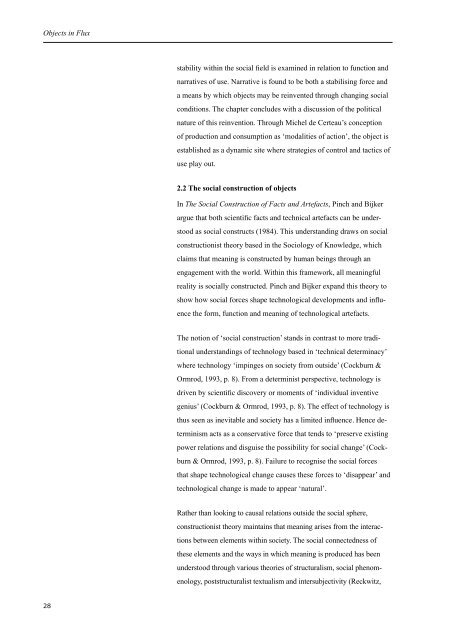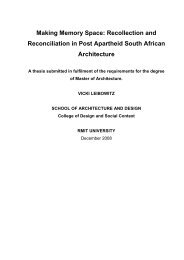Objects in Flux - RMIT Research Repository - RMIT University
Objects in Flux - RMIT Research Repository - RMIT University
Objects in Flux - RMIT Research Repository - RMIT University
Create successful ePaper yourself
Turn your PDF publications into a flip-book with our unique Google optimized e-Paper software.
<strong>Objects</strong> <strong>in</strong> <strong>Flux</strong><br />
28<br />
stability with<strong>in</strong> the social field is exam<strong>in</strong>ed <strong>in</strong> relation to function and<br />
narratives of use. Narrative is found to be both a stabilis<strong>in</strong>g force and<br />
a means by which objects may be re<strong>in</strong>vented through chang<strong>in</strong>g social<br />
conditions. The chapter concludes with a discussion of the political<br />
nature of this re<strong>in</strong>vention. Through Michel de Certeau’s conception<br />
of production and consumption as ‘modalities of action’, the object is<br />
established as a dynamic site where strategies of control and tactics of<br />
use play out.<br />
2.2 The social construction of objects<br />
In The Social Construction of Facts and Artefacts, P<strong>in</strong>ch and Bijker<br />
argue that both scientific facts and technical artefacts can be understood<br />
as social constructs (1984). This understand<strong>in</strong>g draws on social<br />
constructionist theory based <strong>in</strong> the Sociology of Knowledge, which<br />
claims that mean<strong>in</strong>g is constructed by human be<strong>in</strong>gs through an<br />
engagement with the world. With<strong>in</strong> this framework, all mean<strong>in</strong>gful<br />
reality is socially constructed. P<strong>in</strong>ch and Bijker expand this theory to<br />
show how social forces shape technological developments and <strong>in</strong>fluence<br />
the form, function and mean<strong>in</strong>g of technological artefacts.<br />
The notion of ‘social construction’ stands <strong>in</strong> contrast to more traditional<br />
understand<strong>in</strong>gs of technology based <strong>in</strong> ‘technical determ<strong>in</strong>acy’<br />
where technology ‘imp<strong>in</strong>ges on society from outside’ (Cockburn &<br />
Ormrod, 1993, p. 8). From a determ<strong>in</strong>ist perspective, technology is<br />
driven by scientific discovery or moments of ‘<strong>in</strong>dividual <strong>in</strong>ventive<br />
genius’ (Cockburn & Ormrod, 1993, p. 8). The effect of technology is<br />
thus seen as <strong>in</strong>evitable and society has a limited <strong>in</strong>fluence. Hence determ<strong>in</strong>ism<br />
acts as a conservative force that tends to ‘preserve exist<strong>in</strong>g<br />
power relations and disguise the possibility for social change’ (Cockburn<br />
& Ormrod, 1993, p. 8). Failure to recognise the social forces<br />
that shape technological change causes these forces to ‘disappear’ and<br />
technological change is made to appear ‘natural’.<br />
Rather than look<strong>in</strong>g to causal relations outside the social sphere,<br />
constructionist theory ma<strong>in</strong>ta<strong>in</strong>s that mean<strong>in</strong>g arises from the <strong>in</strong>teractions<br />
between elements with<strong>in</strong> society. The social connectedness of<br />
these elements and the ways <strong>in</strong> which mean<strong>in</strong>g is produced has been<br />
understood through various theories of structuralism, social phenomenology,<br />
poststructuralist textualism and <strong>in</strong>tersubjectivity (Reckwitz,
















